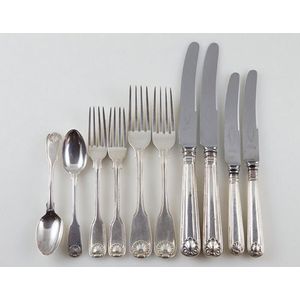Hanoverian Silver Flatware Set with 7386 gms Silver
You must be a subscriber, and be logged in to view price and dealer details.
Subscribe Now to view actual auction price for this item
When you subscribe, you have the option of setting the currency in which to display prices to $Au, $US, $NZ or Stg.
- Rat Tail - A spoon with a flattened handle, tapering from the narrow section at the bowl, and wider as the top of the handle, that when viewed from above is of a similiar shape to a rat's tail. Also known as the Hanoverian pattern, as its manufacture spanned the reigns of George I, II and III (part) of the House of Hanover dynasty. The rat tail pattern was the forerunner to the Old English pattern.
- Pistol Grip - Usually found on knives, and in use from about 1730, the pistol grip handle tapers out from the blade toward the end of the implement, and then curls in the shape of the truncated handle of an early pistol.
The grip is seen occasionally on forks, and also used to describe the handles on an urn where the handle rises up from the body of the urn towards the top, but turns down before meeting the neck, leaving a gap between the neck and the handle - Circa - A Latin term meaning 'about', often used in the antique trade to give an approximate date for the piece, usually considered to be five years on either side of the circa year. Thus, circa 1900 means the piece was made about 1900, probably between 1895 and 1905. The expression is sometimes abbreviated to c.1900.
- Flatware - An alternative name for items of cutlery, principally knives, forks and spoons, now generally used to describe sets of these implements. Nowadays it is mostly used when describing cutlery made of silver and silver plate.
It is less frequently used to describe all "flat' items of tableware, so that as well as cutlery the definition includes plates.
This item has been included into following indexes:
- butter knife / knives - silver items 182
- fruit service / set - silver items 104
- silver cutlery / flatware, patterns
- silver cutlery / flatware, settings - unboxed 1,412
- spoons, silver - grapefruit 22
- Vander, C. J. (London) - silver, maker or retailer 37
Visually similar items

American sterling silver cutlery setting in a fitted canteen, consisting of a cake knife, a carving knife and fork, twelve main knives, twelve entree knives, a twelve pate knife, twelve main forks, twelve entree forks, twelve sweet meat forks, twelve desse

Set of six sterling silver grape fruit spoons, marked H&H, Birmingham, 1932, approx 88g, approx 13 cm long (6)

A Walker & Hall silver plate thirty piece cutlery set, Kings pattern, setting for six, includes dessert spoons, entree & dinner forks, dinner knives & serving spoons

62 piece sterling silver suite of cutlery fiddle, shell and thread pattern, various dates
